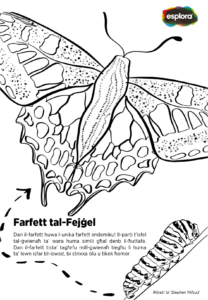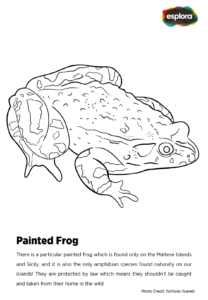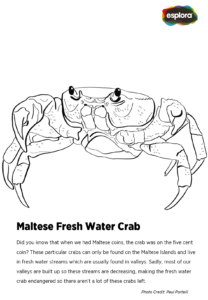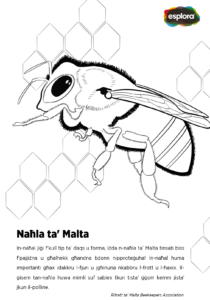Celebrate your child’s creativity and invite them to draw their own unique animal. Children are naturally born artists and inventors so encourage them to draw from their imagination. To help them along ask them:
We’d love to see your child’s creation! So please do send us your pictures on social media and tag us @esploramalta on facebook or Instagram #esploramalta
Today we’re going to take a look at a few of the animals that can be found on our islands! We’ve prepared a set of colouring pages illustrating 11 amazing animals to look out for when we’re able to enjoy nature once again.
Colouring pages (download PDF to print):
2-colouring-pages_annimali-endemici-u-indigeni_malti
2-colouring-pages_endemic-indigenous-fauna_english




How many of these animals did you already know about? And how many of them have you already seen?
Even though our islands are small, we can proudly say that we have quite a few indigenous and endemic animals. What does this mean and what’s the difference between the two?
Indigenous species are plants or animals that can be found naturally in a particular place, meaning that they came to be on our islands through natural processes, and were not brought over by humans. An indigenous animal on our islands is the scorpion Euscorpius sicanus. We only have one indigenous scorpion on our islands, but it’s not endemic- in fact it’s also found in Italy, Greece, Tunisia, Libya & Egypt.
On the other hand, endemic species are plants or animals that live only in a specific area. So, when we say that an animal is endemic to the Maltese islands, this means it can only be found here and nowhere else around the world.
Did you know that endemic species are more likely to develop on islands such as ours, since we’re isolated and far away from other countries? Amazing right? Unfortunately, this means that if we damage their habitat (their home) or ecosystem (their natural ‘community’ of both living and non-living things), these animals could become extinct, meaning that they will be gone forever. This is why most of these animals are protected by law.
Take the example of the freshwater crab, Qabru in Maltese. Did you know that these crabs moved to our islands around 2,000 years ago? Researchers believe that the level of the Mediterranean Sea went down during that time, creating ‘bridges’ for animals such as the freshwater crab to cross to come to our islands.
Unfortunately, these crabs have been decreasing in numbers over the last few years and are now endangered. Why? Well, one of the reasons has been climate change – we don’t always have wet winters full of rain and this negatively affects freshwater crab since they need to live in streams of freshwater.
Another problem that these crabs are faced with is construction. Most of the freshwater streams are found in valleys, and we don’t have a lot of these streams anymore since we’ve built a lot of buildings and roads in valleys. We’ve destroyed a lot of their habitats and now Maltese Freshwater Crabs do not have a lot of places which they can call home.
And if they don’t have a hard time surviving as it is, they also have to face their latest problem; crayfish. Research shows that there are at least five different types of crayfish currently living in our valleys. These animals are not found naturally on our islands, so they’re considered to be ‘alien’ species, meaning that they were brought over to islands by humans and either escaped or were let loose in the wild.
But why is this a problem? Well crayfish eat animals that live in freshwater, such as the endemic Maltese Freshwater Crab and the indigenous painted frog! They reproduce quickly, are not picky eaters (they even eat each other!) and are also very tough and can survive in dry winters.
But crayfish are not harmful simply because they’re crayfish – that would be unfair. No, they’re harmful because of the place they were moved to – our islands. In their natural habitat, such as in North America, crayfish would have other animal competitors and environmental factors to naturally control their numbers. But here, on our islands, they have almost no competitors, so their numbers keep growing and growing! They also damage the ecosystem and make it difficult for other freshwater creatures to survive; making animals such as the freshwater crab and the painted frog endangered and in need of protection. This is why crayfish are considered as ‘invasive’ alien species here on the Maltese Islands.
So what can WE do about it?
We would like to thank the dedicated individuals of the Facebook group Maltese Entomology and Wildlife & Wildlife in Focus (hyperlink https://www.facebook.com/FocusWildlife/) for answering all our questions and for their amazing photos which we were able to use for reference. Make sure to also check out http://www.maltawildplants.com/ for more information on plants and animals found on our islands.
Greenhouse, a local NGO, is inviting you to snap a photo of your wild neighbours! As we spend more time indoors, let’s discover what animals we share our home, yard or garden with. Bees, beetles, ants, moths – the world is full of amazing creatures. If you spot an animal, just take a photo, and upload it to Facebook or Instagram with the hashtag #greenhousengo and #wildneighbours.
Let’s showcase the diversity of animals we share our homes with!
For more information, check out their Facebook page @GreenHouseNGO